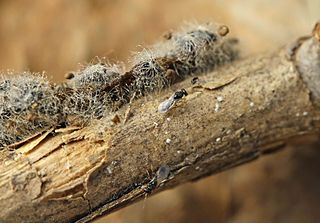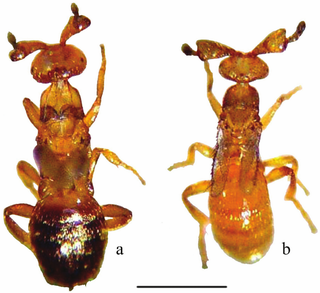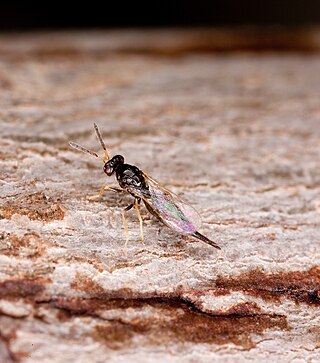
Diplolepis is a genus of approximately fifty species of gall-inducing wasps in the family Diplolepididae. The larvae induce galls on wild roses (Rosa), and rarely on domestic roses.

The Eulophidae is a large family of hymenopteran insects, with over 4,300 described species in some 300 genera. The family includes the genus Elasmus, which used to be treated as a separate family, "Elasmidae", and is now treated as a subfamily of Eulophidae. These minute insects are challenging to study, as they deteriorate rapidly after death unless extreme care is taken, making identification of most museum specimens difficult. The larvae of very few species feed on plants, but the majority are primary parasitoids on a huge range of arthropods at all stages of development. They are exceptional in that they are one of two hymenopteran families with some species that are known to parasitize thrips. Eulophids are found throughout the world in virtually all habitats.
Aprostoporoides is a small Indomalayan genus of hymenopteran insects of the family Eulophidae which was described in 2004 with two newly described species from Kerala.
Baeoentedon is a genus of hymenopteran insects of the family Eulophidae, they are parasitoids of whitefly from the family Aleyrodidae which are found on trees of the genus Ficus. They have been recorded from Australia, China, India, Indonesia and Florida. A fifth species, Baeoentodon farazi, was described from Karnataka, India, in 2017.
Chouioia is a genus of endoparasitic wasp of the family Eulophidae. Chouioia cunea is considered an important parasite of the fall webworm in China, where the moth is an invasive species.

Colpoclypeus is a genus of hymenopteran insects of the family Eulophidae.
Emersonella is a genus of hymenopteran insects of the family Eulophidae. Several species are known to be phoretic parasitoids of female tortoise beetles, laying their eggs in the eggs of the beetle host.
Eprhopalotus is a genus of hymenopteran insects of the family Eulophidae. Their distribution varies between species but ranges from Costa Rica, Mexico to Texas. There are currently 5 species of Eprhopalotus:

Euplectrus is a genus of hymenopteran insects of the family Eulophidae.

Horismenus is a genus of hymenopteran insects of the family Eulophidae occurring primarily in the Americas. As of 2015 over 400 species in the genus have been described. Horismenus species are often described as parasitizing other insects.
Kokandia is a monotypic genus of hymenopteran insects of the family Eulophidae. The only known species Kokandia salsolicola is a parasitoid of gall midges belonging to the family Cecidomyiidae which use plants of the goosefoot genus Salsola as hosts.

Leptocybe invasa, the blue gum chalcid wasp or eucalyptus gall wasp, is a chalcid wasp which is the only species in the monotypic genus Leptocybe in the subfamily Tetrastichinae, of the family Eulophidae. It is a gall wasp which causes the formation of galls on a number of species of Eucalyptus, it was described in 2004 after galls were found in river red gums in the Mediterranean and Middle East and has since been found to be a widespread species where its host trees are planted. It is indigenous to Australia.

Melittobia is a genus of hymenopteran insects of the family Eulophidae.
Neotrichoporoides is genus in the family Eulophidae, containing approximately 70 species.
Nesolynx is a genus of hymenopteran insects of the family Eulophidae.

Pnigalio is a genus of hymenopteran insects of the family Eulophidae. Nearly 100 species have been described of which about half may be valid. All species are parasites of other insects. Their biology varies widely among those species that have been studied. Some are ectoparasites, others parasitoid, and still others are hyperparasitoids and their hosts include beetles, flies, hymenopteran and lepidopterans.

Quadrastichus is a genus of hymenopteran insects of the family Eulophidae.

Tetrastichus is a genus of hymenopteran insects of the family Eulophidae.

Tetrastichinae is a subfamily of the chalcid wasp family Eulophidae. It is one of the largest subfamilies of the Eulophidae containing over 100 genera and nearly 3,000 species. The species of the family Tetrastichinae are found in almost any type of terrestrial habitat and have a worldwide distribution, except Antarctica. They show a varied biology and hosts for Tetrastichinae wasps have been identified from over 100 different insect families, across 10 different orders and they have also been recorded as being parasitoids on nematodes, mites and spiders' eggs. Some species are even phytophagous, while others are inquilines and yet others are gall formers.
Baeoentedon bouceki is a species of wasp, one of the first three members of the genus Baeoentedon to be discovered in China. It is less than a millimetre in length, with a head slightly wider than the middle portion of the body. Only one specimen has been studied, collected from Hainan in 1983. As that specimen is female, the appearance of males is unknown.








